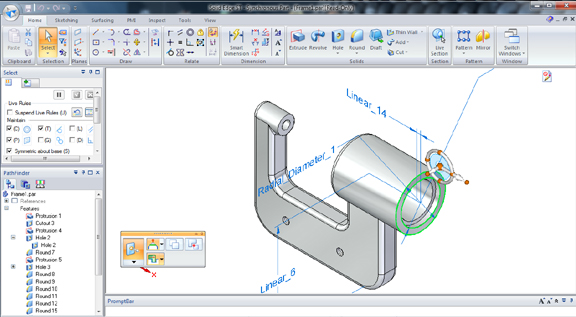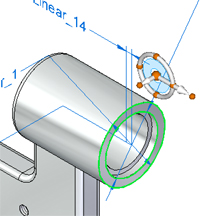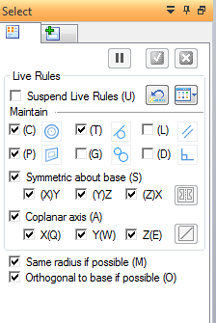Latest News
March 2, 2010


I’m probably going to ruffle a few feathers with this observation, but I believe it’s backed by experience, yours and mine.
In general, a history-based parametric program is not ideal for concept exploration. In the design phase where you’re toying with various shapes, experimenting with numerous parameters, a CAD program’s parametric history is more a limitation than an enabler. A feature history is like a stack of dominoes, each one sitting on top of another. Every time you execute a change that violates the hierarchy of steps, you risk a regeneration failure.
So, over time, you learn to use CAD to draw with precision, to build your geometry with careful consideration. If you’re still pursuing competing ideas and don’t know how your design will look like in the end, you’re much better off using a 3D modeler that lets you build, break, and rebuild your geometry with reckless abandon (for example, Google SketchUp or bonzai3d from Autodessys).
But Solid Edge with Synchronous Technology (ST) may be an exception.
Common Arguments Against Direct Modeling Don’t Hold Water with ST
Up to this point, all my coverage of ST has been second-hand accounts: I wrote about the demonstrations and presentations I’d seen; I’d never had the chance to use the software personally. Last week, courtesy of Siemens PLM Software, I received a trial copy of the software.
Years of tech reporting makes me allergic to marketing slogans. I take into account the possibility that a technology works flawlessly during a demo only because the presenters have used sleight-of-hand tricks to impress me over WebEx. But having used Solid Edge with ST, I can wholeheartedly agree with Siemens’ claim that it “combines the best of constraint-driven techniques with direct modeling.”

Though the software encourages you to shape your geometry directly by pushing, pulling, and rotating faces and features, it also catalogs the features (holes, protrusions, rounds, blends, and so on) in your part. Should you choose to go back to any of them and readjust the parameter or position (say, the placement and radius of a hole), you can simply double-click on that feature to launch the control handles (shaped like a cartwheel with pointers).
Unlike the features in a history-based parametric modeler, ST features are not order-dependent, so you can make changes to any of these features in any order. One of the commonly used arguments against direct modeling is that it’s impossible to modify your design after the fact because you created the geometry on the fly. This argument simply isn’t valid with Solid Edge with ST.
Nor can you employ the other frequently used argument that direct modelers don’t let you preserve design intent. If, by design intent, you mean the geometric relationships (the hole must remain fixed to the center of an outer arc, the inner wall must remain parallel to the outer edges, and so on), you’ll find that ST’s Live Rules can manage and maintain these associations just as well as any history-based parametric modeler.
Furthermore, you’ll be able to do something in ST that’s not so easy to do in a traditional CAD program: you can temporarily suspend some or all of these geometric relationships (for example, execute a change on only one side of a mirrored feature without affecting the opposite side).
With Solid Edge with ST, you’re encouraged to take a different approach to modeling. Unencumbered by history, you could freely use features (holes, bosses, thin walls, and so on) as place-holder objects while you explore design options. The ease with which you can modify your geometry makes it a better environment to innovate, not just document ideas.
Here’s a video review of the basics I discovered:
For more, read Part II, “Stress Relief” (March 20, 2010).
Subscribe to our FREE magazine, FREE email newsletters or both!
Latest News
About the Author
Kenneth Wong is Digital Engineering’s resident blogger and senior editor. Email him at [email protected] or share your thoughts on this article at digitaleng.news/facebook.
Follow DE





